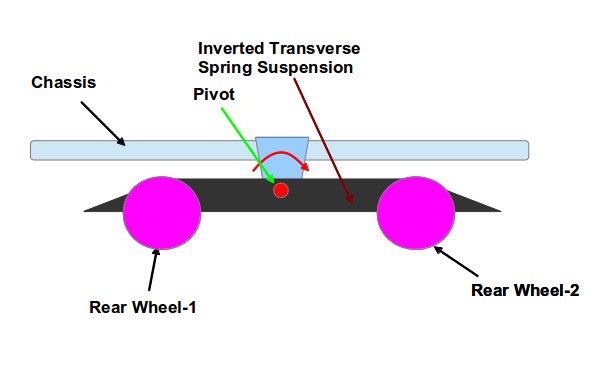The inverted or transverse spring tandem axle suspension has lot of similarity with the tandem twin axle bogie suspension system as far as functioning is concerned. Both of them are used with the heavy duty twin (or multi) axle trucks and trailers. Having said that, they are different in terms of construction.
So, how it looks?
As the name suggests, the arrangements of the leaf springs are “inverted or up side down” than the ordinary leaf springs suspension. In case of the inverted (or transverse) spring tandem axle suspension, the smallest length leaf spring seats at the top and the longest leaf stays at the bottom.

See the arrangement at the above picture, the twin tandem axle with the two pairs of wheels are connected with the chassis by means of a pivoted joint, which allows the wheel pair to oscillate in sync with each other and that’s how the magic happens while they are in work.
How it works?
As soon as a heavy truck with twin axles hit a hump (or a dip pit) into the road, the wheel, which is actually facing the hump (or dip pit) will tend to lift up (or go down).
Now, in case of uncompensated or normal leaf spring suspensions, the other wheel (which is not actually facing the hump) will also get lifted up since both the wheels are connected individually with the chassis. And this is the drawback of normal twin axle suspension, because it may causes damage to the vehicle as well as to the roads.
This problem can be overcome by using the Inverted leaf spring tandem axle suspension. How? See the picture below:

As you can see from the above picture, in case of transverse tandem suspension, the whole system gets tilted about the pivot and although the front wheel get lifted with the hump, the rear wheel gets itself lower to keep making contact with the ground. Thus avoiding the excessive stress developed in the suspension, axle, and the roads.
Hi, I am Shibashis, a blogger by passion and an engineer by profession. I have written most of the articles for mechGuru.com. For more than a decades i am closely associated with the engineering design/manufacturing simulation technologies. I am a self taught code hobbyist, presently in love with Python (Open CV / ML / Data Science /AWS -3000+ lines, 400+ hrs. )

very clear and clean explanation and is very simple to understand…compliments suvo..
very clear and clean explanation and is very simple to understand…compliments suvo..
I am making a tandem axle utility trailer rigid frame no suspension. I am using inverted leaf springs and shackles to support the load deck with integral pivot for the deck to pivot for loading cargo. The load deck sprung to dampen cargo road loads. Also the tow bar type articulated from the fwd axle will enable equal axle loading because the ball loading will always remain the same that being 1/2 the tow bar weight. Because the tandem axle frame is rigid and articulates by the tow bar do you think this is legal design for DOT? Its kinda like a barn yard 4 wheel trailer but the front axle doesn’t turn and the spacing between the front and rear tires is about 1 tire diameter. I suspect tire skidding in sharp turns but I don’t expect the centroid of mass of the cargo to be unstable fwd/aft in accelerations such to lift either axle. Please if anyone has critical design comments please comment. Thanks, Bryce